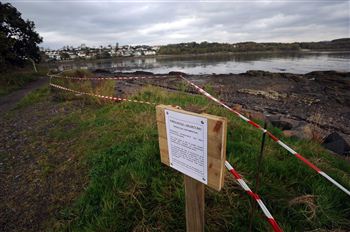SCOTTISH Government scientific advisors have found nearly double the level of cancer in people living near a radioactive beach.
A report for the Department of Health advisory committee revealed an increase in liver and blood cancers in people living next to Dalgety Bay in Fife.
The report shows that liver cancers were concentrated in communities near the polluted shore which “reinforces” suspicion that there were links between the discarded radium that has littered the area for decades, and cancer.

Scientists now want an investigation into the potential links between the radioactive site and cancer levels.
Gordon Brown, MP for Kirkcaldy and Cowdenbeath, called for further investigation into the matter after local residents demanded an in-depth inquiry.
He said: “Local residents will rightly want and expect more detailed studies done with the greatest of precision to reassure them about their safety.”
The UK Government Health Protection Agency (HPA) issued advice last month that public health risks from radiation at Dalgety Bay were low.
However, this has now been undermined by the report for the Committee on Medical Aspect of Radiation in the Environment (Comare) which has advised ministers in both Holyrood and Westminster.
The “Preliminary Report on Cancer Rates around Dalgety Bay” was presented to Comare’s on October 10 which showed there had been a significant excess of liver cancers around Dalgety Bay between 2000 and 2009.
They expected four cases but there were instead ten.
All cases were found in “data zones” which are nearest to the contaminated area.

There was “a pronounced tendency for the observed cases to be close to the headland”, the report concluded.
The report also stated that “it is recommended that there should be further investigation of these cases and an analysis of earlier data if available.”
A significant excess in lymphomas, cancers of white blood cells, was also found with 27 cases found around Dalgety Bay when only 16 were expected.
Alex Elliott, a Glasgow University physics professor who chairs Comare and an expert group on Dalgety Bay, accepts possible links between liver cancers and contamination but stresses that there could be other causes.
He said: “While exposure to radium cannot be excluded as a cause, there are other risk factors more closely associated with this disease.”
Comare is now doing further investigations with the aim of producing a final report by early next year.
Mr Elliott has previously been critical of the HPA’s reassuring line on public safety.
Colin McPhail, chairman of the Dalgety Bay and Hillend Community Council, said he was concerned by the findings.
He said: “There should be a detailed investigation by NHS Fife.
“The local residents are owed that.”
The Scottish Environment Protection Agency (SEPA) explained that some of the particles found at Dalgety Bay could be a “significant hazard” to people who come across them.
Dr Paul Dale, SEPA’s radioactive substance specialist, said: “We believe that the public should be protected from such an encounter as far as is practical.
“While there continues to be uncertainty about the risks, SEPA believes that it need to be precautionary in its approach and will continue to act to protect the public and environment, when there is a significant possibility of harm.”
The HPA defended its advice that the public health risks were low and was backed by the Ministry of Defence (MoD).
A spokesman for the MoD said: “The MoD continues to assist SEPA on a voluntarily basis without prejudice to determine the scope of any action.
The Scottish Government have promised to work with other agencies to further investigation to see if there was an increased health risk.
A spokeswoman for the Scottish Government said: “We fully appreciate the considerable anxiety this long-running issue has caused the local community and hope the MoD continues to deal with this as a matter of urgent concern.”
Radioactive contamination was first found on the beach in 1990 and is believed to come from radium that was used to illuminate the dials of aircrafts which was disposed of in the area after the Second World War.
Over 2500 radioactive hotspots have been discovered on the foreshore over the past 22 years with more than 1000 since September since 2011.
Investigations continue into the contamination.

